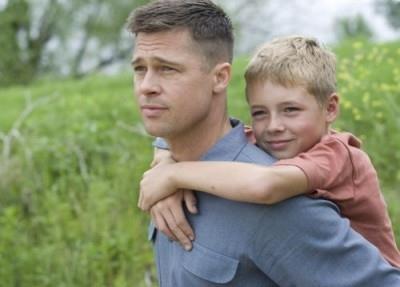Dir/scr: Terrence Malick. US. 2011. 138mins

A cinematic symphony more than a classic narrative film, Terrence Malick’s long-awaited The Tree Of Life has moments of breathtaking visual and aural beauty, but in the end it has us longing for the days of Badlands, Days Of Heaven or The Thin Red Line, when the Texan auteur also knew how to spin a good yarn. In his previous films, a sense of wonder at the mysteries of nature, the human spirit and the cosmos was always there in the background, lifting, contrasting and sometimes ironically critiquing the main story. In The Tree Of Life, it very nearly is the story — and the result is a cinematic credo about spiritual transcendence which, while often shot through with poetic yearning, preaches too directly to its audience. If ever a whole film were on the nose, this is it.
Smoky nebulae, gushing lava, the corpuscular pulse of flowing magma, sunrise and star-rise, amoeba and jellyfish, hammerhead sharks and CGI dinosaurs all feature.
The reputation of Malick, the presence of Brad Pitt (who also co-produced), and the packaging of the film as a unique cinematic experience - though not, it should be noted, a 3D one - will help at the box office. And the mixture of boos and applause that greeted the film’s Cannes press premiere suggest that some media reactions will be more upbeat than this one. But if it’s true, as some reports suggest, that the film’s budget exceeded the $32m initially announced, breaking even is going to be a struggle. The Tree Of Life is a more focused film, and a better one, than Darren Aronofsky’s The Fountain - but that pompous New Age saga’s poor box-office performance is still probably a good benchmark for a film that requires a serious leap of faith, and poker-straight faces, from its audience.
The quotation from the Book Of Job that introduces the story signals the fact that we’re in Biblical territory, in the field of parable rather than the muddy swamp of narrative realism. In the first of the film’s four movements - to use a musical metaphor that is touched on more than once in the story - fragments of the lives we will be following are woven together impressionistically, linked by Malick’s familiar poetic, rhetorical voiceovers: characters (not always identifiable at first) talk about the two opposing life forces, strong but selfish nature and vulnerable but selfless grace, which are soon identified respectively with the stern father (Pitt, solid in the role) and the radiant, loving mother (a bravura performance from Chastain) of the 1950s suburban family we begin to follow.
A tragedy - the death of their 19-year-old son - is announced via telegram; we cut to a city scene, where a drawn and intense Sean Penn drifts between his boxy modernist steel and glass house and the New York skyscraper where he works, apparently as an architect. We work hard at first to connect these plot scraps — the task not being made any easier by the almost complete absence of dialogue.
The second part of the film, designed with the help of 2001: A Space Odyssey and Blade Runner special-effects veteran Douglas Trumbull, is the most audacious: an impressionistic cinematic history of the universe in around 20 minutes, from its beginnings in cosmic dust to the appearance of life on earth. Smoky nebulae, gushing lava, the corpuscular pulse of flowing magma, sunrise and star-rise, amoeba and jellyfish, hammerhead sharks and CGI dinosaurs all feature in a virtuoso peformance that stands in the same relation to the rest of the film that a flashy guitar solo does to the main melody.
It’s only after around 55 minutes that the main narrative kicks in. We’re back with the family we met earlier, but years before that telegram. Three boys are born to a couple who live in a classic American suburban house with a lawn outside dominated by a spreading oak tree. Dad, a former air force officer, works in a factory and hopes that certain patents he has taken out will make the family rich, though his real passion is classical music (he plays the organ in church). Mom is a housewife and homemaker. Gradually conflict develops between the authoritarian father and his eldest son, Jack (an excellent, intense debut by young McCracken).
We’re in Oedipal territory here, and in case we don’t get the message, Jack is given on-the-nose, character-defying lines like one he delivers to pa: “I’m as bad as you are - I’m more like you than her.” By now, we have realised that the Sean Penn character, who has taken to wandering anguished in his designer suit through rocky deserts, is Jack in adulthood. The film’s short final movement has him greeting all those he has known on a beach, in a valedictory dream sequence that does pack a certain elegiac punch.
The camera is always moving, panning, gliding away, as if impatient to get to the imminent truth that lies behind this shabby reality - a truth that finds its expression in the soundtrack of transcendental choral or stately orchestral music by composers from Respighi and Mahler to Taverner and Gorecki. The problem is, we need a little shabby reality every now and then. That’s how cinematic poetry is earned.
Production companies: River Road Entertaiment, Plan B Entertainment, Brace Cove Productions
International sales: Summit Entertainment, www.summit-ent.com
Producers: Sarah Green, Bill Pohlad, Brad Pitt, Dede Gardner, Grant Hill
Executive producer: Donald Rosenfeld
Co-executive producers: Steve Schwartz, Paula Mae Schwartz
Co-producer: Nicolas Gonda
Cinematography: Emmanuel Lubezki
Editors: Hank Corwin, Jay Rabinowitz, Daniel Rezende, Billy Weber, Mark Yoshikawa
Production designer: Jack Fisk
Music: Alexandre Desplat
Main cast: Brad Pitt, Sean Penn, Jessica Chastain, Fiona Shaw, Irene Bedard, Jessica Fuselier, Hunter McCracken, Laramie Eppler, Tye Sheridan





















